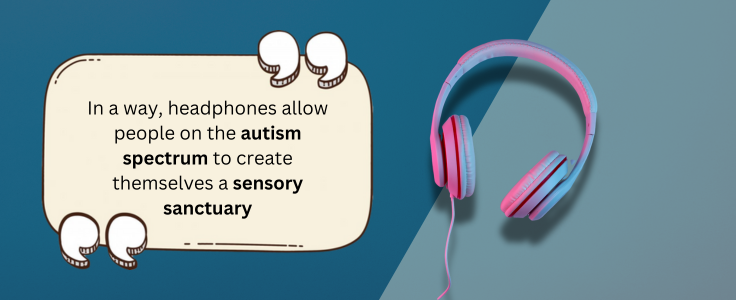Why Do People with Autism Wear Headphones?
People with autism commonly struggle with sensory sensitivities. These could manifest themselves in multiple ways, such as being hyposensitive or hypersensitive to certain stimuli, including touch, sound, smell, taste and light.
Some people who have autism spectrum disorder (ASD) might struggle with strong odors, bright lights or certain textures. Conversely, some people with ASD might not experience decreased sensory experiences from these same things.
The important thing to remember with autism is that it affects different people in different ways. That’s why it’s referred to as ASD today, because the neurodevelopmental disorder really does span a wide spectrum.
Those who do experience sensory sensitivities respond in different ways. Sensory stimuli may cause people with autism to feel overwhelmed, stressed, anxious and more.
That’s why some people with autism wear headphones — to help them deal with sensory overload they may be experiencing in certain situations.
Below, we’ll dive deeper into the role that headphones play for some people with autism.
Table Of Contents
What Do Headphones Do for People with Autism?
Headphones serve a common person for all people, regardless of their developmental abilities — they direct specific sounds to a person’s ears while drowning out other noise around them.
Neurotypical individuals wear headphones for a variety of reasons, from playing music, podcasts, movies or TV shows. Oftentimes, this is played in the background while they work, exercise, or ride in a car, airplane or car.
People with autism use headphones for the same reason. It helps them drown out the outside noise and keep themselves centered with only specific sounds.
In a way, headphones allow people on the autism spectrum to create themselves a sensory sanctuary. They can play calming music, repetitive sounds or anything else that helps them to feel relief, calm and comfort.

What Could Trigger People with Autism to Need Headphones?
It’s important to reiterate that every person with autism is different, and what might trigger one person to need or want to use headphones could be different than others.
That being said, there are a few common reasons why people with autism wear headphones.
One of the main reasons is that they are hypersensitive to noise. In these cases, it might not just be that loud noises or sudden noises create internal issues. It could also be everyday noises such as cars driving, birds chirping or people talking.
It’s easy to imagine how a person who’s experiencing something like this could easily become overwhelmed. That’s why they might wear headphones — to help them better manage the auditory environment around them so that they can go about their day and be productive.
Individuals with ASD also commonly experience sensory overload. When this happens, they might engage in self-stimulatory behaviors, also known as stimming. This could be biting their nails or tapping their fingers repeatedly, for instance.
Sometimes, it’s best for people with autism to go to a separate room filled with calming stimuli so they can re-center themselves when this might happen.
It’s also possible to prevent this sensory overload from happening by using headphones. Since headphones allow the person wearing them to focus intensely on what’s in front of them — and not get distracted or consumed with what’s going on around — they can actually help them be more self-regulated and not become overwhelmed.
This is true for people with autism who have sensitivity to noise or any other stimuli, in fact.
What Type of Headphones are Good for People with Autism?
You might often see people with autism wear over-ear headphones as opposed to earbuds that many other people use. The reason for that is quite simple — they help to drown outside noise out better and create an auditory environment that’s much more soothing and less distracting.
These headphones completely cover a person’s ear and are very good at blocking out sounds from the outside. Not only that, but they are often more comfortable to wear, which is extra important for people who have autism.
Earbuds, by contrast, actually have a higher likelihood of presenting a sensory overload when it comes to touch, since something will be going inside the person’s ear. Over-ear headphones are similar in many ways to earmuffs or other hats that might cover someone’s ear — meaning they are worn in a more familiar way.
That being said, any type of headphones work in achieving their goal for people with autism. It’s all about what preferences the person has.
Blue Gems ABA Supports Children with Auditory Sensitivities
People with autism often wear headphones to help keep them grounded, to drown out external noise and to make them feel less stressed, anxious and overwhelmed by the environment around them.
At Blue Gems ABA, we help to support children on the autism spectrum who have auditory sensitivities and any other needs when it comes to sensory stimuli. We have a team of experienced BCBAs who are dedicated to administering applied behavioral analysis, or ABA therapy, to children with autism.
By catering ABA therapy treatment plans to each individual’s strengths and weaknesses, we use positive reinforcement and repetition to help children modify certain behaviors and build the social, communication and daily life skills with which they typically struggle.
To learn more, please contact us today.




